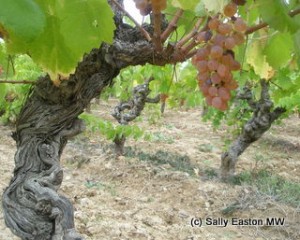White wine phenolics

Bourboulenc a week from picking
When a vertical tasting of bourboulenc at Château d’Anglès, in Languedoc’s La Clape followed on the heels of a viognier masterclass by viognier virtuouso Louisa Rose, one can’t help but tweak one’s thinking on the roles of acidity, freshness and phenolics (essentially tannin) in white wine. Neither grape is particularly well endowed with raging acidity, but both have thick skins which impart a phenolic texture and freshness to the wines they make.
Louisa Rose, head of winemaking at Yalumba and Hill Smith Family Vineyards in Australia, aired some useful points on the subject during a recent visit to the UK, introducing her theme by explaining that “viognier crosses over texturally into red wine.” She’s aware such an idea might take a bit of thinking about, and not all viognier wines are made to express phenolic potential, saying “if I just want a drink, it would be a waste of Virgilius (Yalumba’s top viognier) which will evolve with you through a meal.” The aim for Virgilius, she said “is not such obvious fruit, but more texture in a powerful wine with restraint, and a sense that the wine will open up and evolve, for people who want to think about the wine with their meal.”
Structurally viognier typically has modest to low acidity and alcohol erring to high. This is not automatically going to make a light, zesty, fresh style of wine, but the weight and structure, Rose argued, lend it to the culinary environment. It does have plenty of aroma of lemon and lime, lychees, apricot, to play with. And its thick skins provide a lot of natural phenolics. And it is these phenolics that confer “the apparent acidity and freshness of viognier.”

Louisa Rose
The learning curve on viognier has been quite dramatic. Rose explained “when we let the grapes get riper [going back to the late-1990s], we discovered that at higher sugar levels they got these flavours which come in very quickly, yet much later than other white varieties.” Added to which, Rose said “grapes that were in the sun were getting golden in the sun, and had much more flavour than those inside the canopy.” Letting those thick skins ripen properly was bringing in big flavours and ripe phenolics.
To get the best textural feel into their top viognier Rose uses indigenous yeasts from the vineyards, saying “we get a layering of flavours and textures from yeast.” She added “it seems to be those yeasts in the first few days (non-Saccharomyces yeasts) that give textures, richness, suppleness. Then the Saccharomyces yeasts come in for more fruit flavours. Then after fermentation those early aromas and textures come back again.” And they found the indigenous yeasts gave a better integrated alcohol. Not any less, Rose said, but it didn’t taste as hot.
The pressed grapes go directly to barrel [not new], and because viognier is naturally low in acidity the malolactic fermentation is avoided. Rose said “we don’t want the broadening and fattening you get from malo”.
Yalumba also no longer add sulphur dioxide to Virgilius until the wine gets bottled. Rose explained “phenolics in the juice brown on contact with air, which can be scary” but the brown (oxidised) compounds precipitate out. Rose said “These brown phenolics are the ones we don’t want, and they’re very easy to extract, plenty come out at pressing. And for Virgilius, if we didn’t do this, [the oxidisable compounds] would still be in the wine, and they would precipitate in bottle, giving a brown, broad, oily wine” which is not what they’re after all. “The oxidation of the juice is a really important part of the wine” Rose emphasised, “it gives purity and elegance to the wine, and the ability to age.”
Over in France, the similarly-thick skinned bourboulenc needs plenty of sunshine to ripen properly so basking in its homeland of the Mediterranean is about the perfect environment. Vianney Fabre, of Château d’Anglès, said “the structure and texture of the wine comes from bourboulenc. Even with low acidity, the wine is elegant, easy, and well-balanced. The tannins give freshness and backbone.” Sounds a bit like what Rose was saying about viognier.
See here for a profile and visit notes of Château d’Anglès.
What about chenin blanc, then, anyone?



